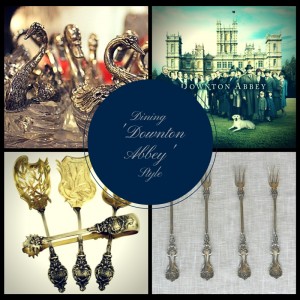A guest blog by Karen Parr-Moody
For several seasons now Downton Abbey has enchanted NPT viewers with the sumptuousness of the Edwardian age as experienced by the aristocratic Crawley family. This British period drama, currently set in 1924, is as soap operatic as it is historic. And it gets the historic details correct when it came to the dining room, which has historically been a stage for displaying one’s wealth.
Elite Edwardians went for lavishness in their meals, which ranged from six courses on up. Their four meals a day – breakfast, lunch, teatime and dinner – necessitated many gold-standard accoutrements. In many dining scenes from Downton Abbey, one gets a glimpse of such accoutrements, including four types of stemware, a silver mustard pot and what historians call an “open salt cellar” or, simply, an “open salt.”
Individual salt cellars became popular in the 1700s. Prior to that time, the custom was for the master of the house to sit before one large and ornate salt cellar. Though the salt shaker was invented in 1858 by John Mason, cellars were typically used for fine dining for decades to follow. Many ladies of today have inherited salt cellars from their mothers or grandmothers, including ones in swan motifs, examples of which may be found locally at antiques dealers like Gas Lamp Too.
Individual salt cellars contained a diminutive spoon which the diner used to scatter salt across his or her food. Collectors today especially value ornate, hard-to-find patterns, such as a set of sterling silver salt spoons in the Gorham’s Kings III pattern (circa 1885) spotted on etsy.com.
Aristocrats of the Crawleys’ stripe also used an astounding array of forks. Beyond the typical dinner and salad forks, there was a fish fork, strawberry fork, dessert fork and oyster fork (to name a few). In one of the Downton Abbey dining scenes the persnickety butler, Carson, schools a footman on the difference between the oyster fork and another fork. The Crawleys would have used three-pronged oyster forks in silver – not silver plate – perhaps in Whiting’s Pompadour pattern, circa 1889, also seen on etsy.com.
In another scene from the series, Cora – a.k.a. Lady Grantham – is shown having tea outdoors. On the table before her is a silver bowl and a pair of sugar tongs. The sugar cube was invented in the 1840s in Moravia, and an afternoon tea party experienced by a proper lady would have included sugar tongs for handling cubes, as well as the proper dessert wares. A late-1800s French dessert set by Paul Canaux & Company, available on 1stdibs.com, includes sugar tongs along with the proper server, fork and spoon, all done in sterling silver vermeil.
Those Edwardians made meals complicated, but the result was a tableaux of beauty. Why not take a page from their book? Salt cellars and sugar tongs are arguably more interesting than their modern counterparts.
Watch Downton Abbey Sundays at 8 p.m on NPT through March 1 (check our schedule for re-airings through the end of March). The Manners of Downton Abbey airs Tuesday, March 10, at 7 p.m.
Karen Parr-Moody has worked for Women’s Wear Daily, Young Miss, In Style and People magazines. Her humorous “Delusions of Glamour” column was a popular feature in Clarksville’s Leaf-Chronicle newspaper. Parr-Moody now writes monthly fine arts features for Nashville Arts magazine, and about art and antiques for her blog, Bunnatine Dreams.
